
Adoption of drones in agriculture – challenges and prospects
Despite Indian agriculture’s contribution to the GDP, India lags in productivity of major crops when compared to countries like the USA, the Netherlands, China etc. Several dimensions and concerns have been identified, and attempts are being made to address them through novel tools and technologies. Though the influence of technology in the agricultural sector has been invariably positive since its commencement globally, the adoption in India has been scratchy. Global governments and businesses have recognized the significance of food security and the consequences of environmental degradation, pollution, and water scarcity; there is a sense of urgency to overcome certain obstacles in crop production. Sustainable land management practices are critical to reverse climate change impact on agriculture, providing “cost-effective, immediate and long-term benefits”[1]. It is the right time for farmers to change their operational mechanism to mitigate the climate change impacts and protect themselves against economic loss. The advent of drones in agriculture is one such technology that can help mitigate climate change impacts and challenges of reducing labour.
The use of Unmanned Aerial Vehicles (UAV) or drones in the agricultural sector has brought about several benefits and poses challenges for the farmers in general and nations in particular. Their use in the agriculture industry is growing and provides an efficient method of sustainable agricultural management. The drones’ use helps agronomists, agricultural engineers, and farmers streamline their operations by robust data analytics to gain practical insights for crop management. Some of the critical data that helps farmers achieve a better yield and higher economic returns are shown in Figure 1.
industry is growing and provides an efficient method of sustainable agricultural management. The drones’ use helps agronomists, agricultural engineers, and farmers streamline their operations by robust data analytics to gain practical insights for crop management. Some of the critical data that helps farmers achieve a better yield and higher economic returns are shown in Figure 1.
Drones can carefully monitor large tracts of lands, assess slope and elevation to identify the most suitable seeding prescriptions. The technology can also provide an overview of plant emergence and population to help advise replanting decisions, thinning and pruning activities, and predicting yields by assessing the weather, growth, vegetation, biotic and abiotic stresses, etc. The high-resolution images from multispectral and hyperspectral imaging can provide crop fertility status, enabling experts to advise on precise fertilizer, water application, and reduce wastage. The expected value of the agriculture drone market is US$32.4 billion indicating that the industry is recognizing the benefits over more conventional methods for increasing farming efficiency. In Brazil, drones have helped reduce herbicide use by 52% in a soybean field.
Notwithstanding the plethora of benefits, the challenges remain, mostly on initial cost, service models, regulatory and security fronts. Most countries, including India, have yet to finalize the regulatory policies for drone use in agriculture. Coupled with this is the lack of expertise in India of the personnel who can fly drones, read the images accurately and provide the specific advisory for various farming operations. Another major concern is the implementation of the regulations, once approved. Specific federal, state and district levels, in some cases, village level (group of villages) agencies need to be formed who are equipped with the expertise, proper authority and technology to monitor the use of drones in agriculture in compliance with regulatory frameworks. It is still a long way before farmers, and other stakeholders in agriculture can use drones efficiently and smoothly to reap monetary benefits.
[1] AR6 Climate Change 2021: The Physical Science Basis. IPCC. https://www.ipcc.ch/report/ar6/wg1/
Author

Connect with Authors at: E-mail agribusiness@sathguru.com.
 Grow Beyond
Grow Beyond 

